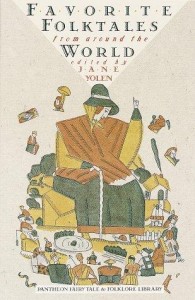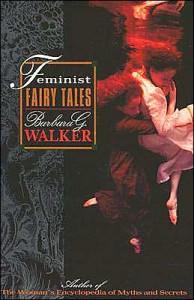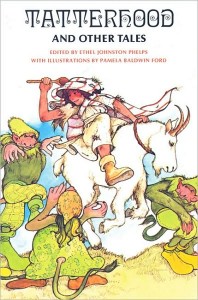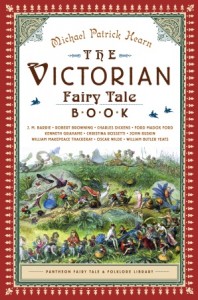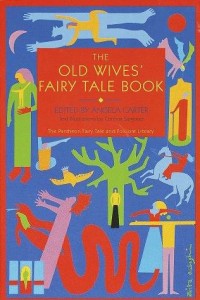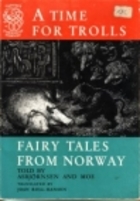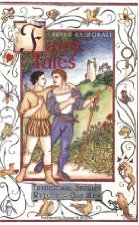A Time for Trolls: Fairy Tales from Norway, edited by Peter Christen Asbjornsen and Jorgen E. Moe (Tokens of Norway, 1962)
Old Wives’ Fairy Tale Book, edited by Angela Carter (Pantheon Books, 1990)
Fairy Tales: Traditional Tales Retold For Gay Men, edited by Peter Cashorali (HarperCollins, 1995)
The Victorian Fairy Tale Book, edited by Michael Patrick Hearn (Pantheon Books, 1988)
Tatterhood and Other Tales, edited by Ethel Johnston Phelps (The Feminist Press at CUNY, 1978)
Feminist Fairy Tales, edited by Barbara Walker (HarperCollins, 1996)
Favorite Folktales From Around the World, edited by Jane Yolen (Pantheon Books, 1986)
What -is- it about fairy tales? Every time you turn around, there’s another retelling, another version, another collection. Whether it’s Disney doing an animated take on Snow White, Sleeping Beauty, or Little Mermaid, or The Tenth Kingdom miniseries currently running on American television, or the umpteenth remake of Alice in Wonderland, or one more collection of tales to add to the shelves, it’s as though everyone wants in on the act. Everyone wants their say on how the old tales should be told and retold and retold and retold ad nauseum.
Anyone who’s wandered around this site for even a little while is probably familiar with the dozens of ways in which fairy tales can be interpreted and explained. Terri Windling and Ellen Datlow, for example, have made a sizable contribution to the pot with their adult fairy tale anthology series (the sixth and final of which, Black Heart, Ivory Bones, is now out in stores). (FT will be reviewing it shortly.) In these popular collections, authors of all sorts retell fairy tales with a more adult, “now” sensibility, often injecting doses of dark humor, grey morality, and personal issues into the stories. Another effort by Windling is the Fairy Tale series of novels, in which authors such as Pamela Dean, Charles de Lint, and Stephen Brust retell stories in their own manner. In such fashion, we’ve been gifted with looks at Tam Lin; The Sun, the Moon, and the Stars; the Nightingale; and Jack the Giant-Killer.
Fairy tales are versatile, as five minutes with a Jack Zipes book will tell you. When you get right down to it, the setting isn’t important. The people aren’t important. Only the meaning is. Fairy tales are special because they’re full of archetypes. And we all know archetypes.
The Good King. The Wicked Stepmother. The Brave Prince. The Suffering Heroine. The Evil Witch. The Good Fairy. The Talking Animals. Royalty in Disguise. The Unjustly Persecuted.
We know the archetypical stories.
Third son goes out into the world and finds fame and fortune and love. Little girl runs afoul of nasty creature, and is rescued by a hero. Love denied, love triumphant. Evil is punished, good is rewarded. Princess makes promise to frog, finds happiness despite being forced to keep it. Hero/ine undergoes many trials to win their true love back from evil spells.
And so on. Fairy tales are universal. To prove it, I’ve gathered together a collection of books which adequately reflect the wide spectrum of potential.
Tatterhood and Other Tales, edited by Ethel Johnston Phelps, is the first such example. The sole unifying theme behind this collection is that in every story, every tale, “they portray active and courageous girls and women in the leading role.” Each of the stories features a heroine who triumphs over outstanding odds because of her resourcefulness, intelligence, and determination. The stories come from all over the world, from Norway, Wales, Scotland, India, the Ivory Coast, Latin America, Russia and more.
In Tatterhood, we see variations on familiar stories, such as “Janet and Tamlin,” “Kate Crackernuts,” and the title story, “Tatterhood.” As well, unfamiliar stories such as “The Giant Caterpillar,” “Unanana and the Elephant,” and “Clever Manka” are presented. As collections go, this one has been collected quite nicely, with beautiful black and white illustrations by Pamela Baldwin Ford, and a well-written explanatory introduction by the editor. In terms of variety of source material, quality of writing, and enjoyment factor, this book rates fairly high. My own personal barometer was the treatment of “Janet and Tamlin,” one of my favorite stories. They managed to capture the feel and source fairly well, though the pregnancy thread that’s so often present was omitted in this case.
Tatterhood is a respectable, worthwhile edition, especially for the wide range of stories offered, many of which aren’t as well known. It steers clear of the majority of the best-known (thanks to popular culture) tales, and keeps its focus steady. The closing text in the back divides the tales further into Tales of Romance, Family, Relationships, Wit and Humor, Old Women, and Independent Women, further proving its usefulness as a text and a pleasure read.
Along the same vein is Angela Carter’s collection, Old Wives’ Fairy Tales, which provides an extremely well-written, intelligent take on the oral tradition, and the tales which have been passed down throughout the generations.
“When we hear the formula ‘Once upon a time’, or any of its variants, we know in advance that what we are about to hear isn’t going to pretend to be true. Mother Goose may tell lies, but she isn’t going to deceive you in that way. She is going to entertain you, to help you pass the time pleasurably, one of the most ancient and honorable functions of art. At the end of the story, the Armenian storyteller says: ‘From the sky fell three apples, one to me, one to the storyteller, and one to the person who entertained you.’ Fairy tales are dedicated to the pleasure principle, although since there is no such thing as pure pleasure, there is always more going on than meets the eye.”
Furthermore, “These stories have only one thing in common — they all centre around a female protagonist; be she clever, or brave, or silly, or cruel, or sinister, or awesomely unfortunate, she is centre stage, as large as life, — sometimes, like Sermerssuaq, larger.”
Carter understands the value of the “voice” in telling a story. As a result, the stories collected in this volume have been told in their original “voice,” be it North American Ozarks, English dialect, English Gypsy accented, or what-have-you. The stories range across the world, sparing no corner, no heritage, to turn out some of the very best examples of women in fairy tales.
Old Wives’ Fairy Tales is separated into categories such as “Brave, Bold and Wilful,” “Clever Women, Resourceful Girls, and Desperate Stratagems,” “Sillies,” “Witches,” “Moral Tales,” “Unhappy Families,” and “Good Girls and Where It Gets Them.” As we can see, she’s managed to capture a number of the archetypical situations in which our heroines manage to become involved, be it the hapless “Armless Maiden,” the moralistic “Little Red Riding Hood,” the never-satisfied “Woman Who Lived In A Vinegar Bottle,” or the daring “Kate Crackernuts.”
Mind you, that’s only four out of dozens of stories. I highly recommend this book, for quality all around. Angela Carter is one of the better editors you’ll find in the field, and her retellings are noteworthy for capturing the true essence and darkness inherent in fairy tales.
While we’re still on the subject of fairy tales about women, I’d like to talk about Feminist Fairy Tales, edited by Barbara Walker (author of The Women’s Encyclopedia of Myths and Secrets, among other feminist-aimed books). As you can guess, these aren’t just stories about women. No, they’re fairy tales told about, for, and by women. In some cases, male characters and protagonists have undergone a sex change during the retelling. Hence, stories like “The Empress’s New Clothes” and “Ala Dean and the Wonderful Lamp.”
One of my favorites in this book is the retelling of Thomas Rhymer, yet another ballad I claim a fondness for. In this case, it’s a beautiful, haunting story that captures the feel and tone of the old tale quite nicely. However, like those before her, Walker doesn’t restrict herself to any one area of the world. One of the most disconcerting stories is “Three Little Pinks,” which has a great many familiar elements from the “Three Little Pigs” contained within.
Feminist Fairy Tales is a good collection, though quite naturally, heavily biased towards a female perspective, female empowerment, and female triumph. But it’s an outstanding example of how fairy tales can be rewritten for any set of circumstances, without losing their power. Yes, you can tell fairy tales about women. It’s not a problem. You can turn princes into princesses, heroes into heroines, and so forth. Yes, you can have a story about the Frog Princess instead of the Frog Prince. And with each story proceeded by Walker’s insights into the original source material and her reasons for altering and telling as she does, you can follow the train of thought easily.
Now, I wouldn’t lead you all this way, and not give you some equality. Hence, Fairy Tales: Traditional Tales Retold For Gay Men, edited by Peter Cashorali. Let me explain that, on the whole, I consider myself a heterosexual male. This is important, as it explains my viewpoint. Normally, tales of homosexuality just don’t do anything for me. However, I have to hold out this book as a perfect example of how one can retell fairy tales for another side of the fence. Why have a princess at all? Who needs women? Why can’t happily ever after apply to two men? The stories contained within this volume are eerily familiar, but startlingly different.
Hansel and Gretel, where Hansel becomes a crossdresser, and Gretel his manager. Rumplestiltskin, featuring a miller’s nephew named Stephen, serving as an allegory for AIDS. “The Man Who Was Lovers With A Pigeon.” “Godfather Death,” where the brilliant young doctor risks his all to save a prince. These stories are wistful, magical, and touching, and they throw stereotypes and gender assumptions right out the window.
Admittedly, it helps if your tastes already run in that direction, but Fairy Tales is worth looking for. It’s a good example of the versatility and range in which these stories can take place. Some of the offerings are less subtle and well-crafted than others, but on the whole, it’s a good collection.
Next on the list, we come back to the global perspective, as Jane Yolen offers up, Favorite Folktales From Around the World. Yolen, considered a master in the field of folktales, brings us dozens of stories from just as many countries, far too many to even begin listing. Suffice it to say that versions of all of your favorites are here, and many more obscure, lesser-known, or just plain forgotten stories as well.
The table of contents helpfully divides the stories into categories, including “Death and the End of the World,” “Shape Shifters,” “Fooling the Devil,” The Fool,” “Telling Tales,” and “Ghosts and Revenants,” among others. Every story has its country or ethnicity of origin listed after it, allowing us to see the wide range of sources. Any given category might have stories from Tibet, Siberia, American Indians, Turkey, China, England, Japan, Iceland, Ireland, France, and Eskimo, for example.
What can I say? Yolen is good at what she does. This volume is easy to read, enjoyable, thorough, and possessed of a pleasant voice. You won’t find any radical retellings or variants here. What you will find are folktales as accurate and close to the original sources as possible, ones that contain death, betrayal, murder, mayhem, confusion, heroes, love, and beauty. These are the stories as they’re meant to be told. Sometimes confusing, sometimes shocking, always magical.
And that brings us to The Victorian Fairy Tale Book, edited by Michael Patrick Hearn. Yet another in the Pantheon Library of folklore, this one looks at the intriguing, often paradoxical Victorian era, and what it did for fairy tales. This was the age in which many tales, far too many, lost their “edge” and were sanitized, whitewashed, and toned down for children. This was the era in which fairy tales ceased to be for everyone, and were relegated to the nursery rooms, for children. And in the process, they lost a lot of the sex, blood, betrayal and questionable behavior.
So what does this book have? Well, it has Robert Browning’s “The Pied Piper of Hamelin.” It has Christina Rossetti’s evocative “Goblin Market.” It has William Butler Yeats’ “The Stolen Child.” It has Oscar Wilde’s “The Selfish Giant” and Kenneth Grahame’s “The Reluctant Dragon,” and J.M. Barrie’s “Peter Pan in Kensington Gardens,” as well as stories by E. Nesbit, George MacDonald, and more.
As well, there’s art and illustrations by Arthur Rackham, Dante Gabriel Rossetti, John Gilbert, and more. In short, this is a book filled with stories from the Victorian era, containing the best and brightest, as well as the dark and twisted. No one in their right mind would ever call Oscar Wilde “whitewashed,” and certainly, “Goblin Market” is not a sanitized story. Erotic, sensual, evocative, and powerful, yes.
And therein lies the strength of this book. It makes no assumptions, and no condemnations, it simply presents the material of an earlier, stranger era, and lets us judge for ourselves. The Victorian era is odd, compared to our own, its writing styles much different, but still valid. While the change in style may be disconcerting, the importance of the works and their role in the history and evolution of fairy tales is unquestioned. Hearn’s introduction serves as a worthy steppingstone between today and yesterday.
“The Victorian Fairy Tale Book does not pretend to embrace all aspects of this vast and varied genre. Instead, it only includes outstanding examples of imaginative fiction and poetry, several by writers who were among the greatest writers of their time. Remarkably, though works of fancy, most never intended as anything more than children’s stories, they reflect Victoria’s England better than most of the earnest novels and social tracts of that era…. Some amuse, some enchant, some satirize, some criticize — after all, no one creates an alternate world who is content with his own.”
Finally, we come to an example of tales collected from one specific area. A Time For Trolls is a gathering of stories from the Norwegian fairy tale traditions. Hence, there’s a blending of the familiar (“East of the Sun, West of the Moon”) and the unfamiliar (“Rumble-Mumble Goose-Egg”). There’s not much more I can say about this obscure little book, save that it’s a perfectly satisfactory retelling of traditional tales. The “voice” is there, and as a reflection of Norway’s traditions and past, it succeeds. Good luck finding a copy, as mine is dated 1962, and I originally “borrowed” it from my father, who in turn “borrowed” it from his sister.
Fairy tales are universal. You can retell them as many times as you want, apply them to any situation or set of conditions you like, and they’ll still exist in a primal form. The books I’ve listed are only a mere scattering of the multitudinous takes on fairy tales and folktales that are out there. There’s more every day, with folklorists such as Jack Zipes, Jane Yolen, Josepha Sherman, Terri Windling, and more working to bring back the old tales, interpret them, and expose us to the magic that every story has. So go look for these books, and then strike out on your own, working from bibliographies and recommended reading lists. Above all else, though, enjoy yourself.

